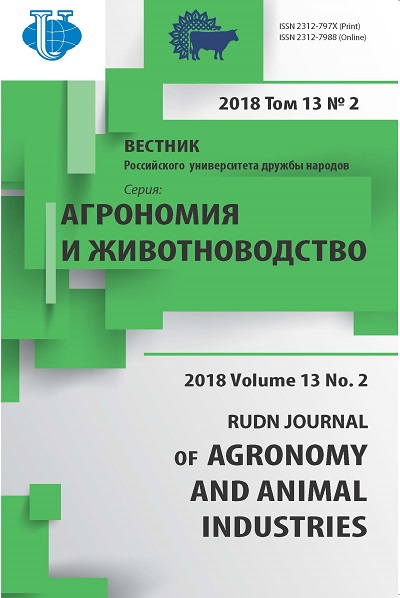Effect of soil treatment and bacterial fertilizers on the productivity of yarn barley
- Authors: Chamurliev OG1, Chamurliev GO2, Feofilova LA1, Parpura DI2
-
Affiliations:
- Volgograd State Agricultural University
- Peoples’ Friendship University of Russia (RUDN University)
- Issue: Vol 13, No 2 (2018)
- Pages: 93-102
- Section: Crop production
- URL: https://agrojournal.rudn.ru/agronomy/article/view/18682
- DOI: https://doi.org/10.22363/2312-797X-2018-13-2-93-102
- ID: 18682
Cite item
Full Text
Abstract
The article presents experimental data on the integrated influence of ways of the basic processing of soil and bacterial fertilizers “Azotovit” and “Fosfatovit” on agrophysical, water-physical soil indicators and productivity of barley. The use of planing treatments leads to compaction of the arable layer above the biological optimum and impaired soil aeration, therefore their application is possible without compromising the cultivation of spring barley. The influence of methods of primary tillage and application of mineral and bacterial fertilizers on barley water consumption and efficiency water production unit. Summarized long-term data on the productivity of spring barley on the learning options. The advantage of the double inclusion “Azotovit” and “Fosfatovit” in the background planing treatment at a depth of 0.20-0,22 m. the yield in this embodiment was 1.7 t/ha, which is higher than where were made only mineral fertilizers - 0,63 t/ha. A calculation of profits, the profitability of the technology of cultivation of spring barley and identified cost-effective version of the experience includes a two-fold introduction of bacterial fertilizers on the background of planing processing of soil to a depth of 0.20-0,22 m. the Margin amounted to 46.2%. On the basis of the conducted researches it is theoretically substantiated, experimentally confirmed and the findings and recommendations of the use of technology in the Volgograd region.
About the authors
O G Chamurliev
Volgograd State Agricultural University
Author for correspondence.
Email: attika.ge@yandex.ru
-
Universitetskiy pr., 26, Volgograd, Russia, 400002G O Chamurliev
Peoples’ Friendship University of Russia (RUDN University)
Email: giorgostsamourlidis@mail.ru
-
Miklukho-Maklaya st., 6, Moscow, Russia, 117198L A Feofilova
Volgograd State Agricultural University
Email: ignateva.l@bk.ru
-
Universitetskiy pr., 26, Volgograd, Russia, 400002D I Parpura
Peoples’ Friendship University of Russia (RUDN University)
Email: admone48@yandex.ru
-
Miklukho-Maklaya st., 6, Moscow, Russia, 117198References
- Belenkov A.I., Holod A.A., Shachnev V.P. Perfection of field crop rotations and basic processing of light chestnut soils in the conditions of the Volgograd region. Proceedings of the TSHA. 2009; 3: 38—45.
- Belenkov A.I. Rotation and soil cultivation in the steppe and semi-desert zones of the Lower Volga Region. Moscow: 2010.
- Semina N.I., Pleskachev Yu.N. Application of bacterial fertilizers in the cultivation of sunflower. Ways to increase the productivity of irrigated agrolandscapes in arid farming conditions: Publishing House “Herald of the Russian Academy of Agricultural Sciences”; 2012;128—131.
- Vakulenko V.V. Growth regulators. Protection and quarantine of plants. 2004; 1: 24—26.
- Demchenko M.M. Influence of bacterial and organic fertilizers on the symbiotic nitrogen fixation and productivity of chickpeas in the subzone of light chestnut soils of the Lower Volga region [Ph D]. Volgograd: 2003.
- Dospekhov B.A. Methodology of field experience. Moscow: Kolos;1979.
- Kostychev P.A. The doctrine of the mechanical treatment of soils. St. Petersburg: The publication of A.F. Devriena. 1885; 245—312.
- Timiryazev K.A. Agriculture and plant physiology. Moscow: 1957.
- Persikova T.F., Cуganow A.R. Agroekologiczhe aspektу zastosowania nawozov komlekowуch wogniwie zmianowania jeoznien + koniczyna. Folia Univ. agr. Stetin. Agr. 1998; 72: 261—263.
- Fedotov V.A. Agrotechnology of cereals and industrial crops in the Central Chernozem Region. Voronezh: Origins; 2004; 40—50.
- Shuvalova O.A. Local aspect of the development of Russia: Environmental sustainability of the Volgograd region. GeoScience. 2013; 99—107.
Supplementary files















